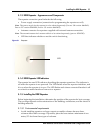
46 Installing the KIRK Wireless Server 600v3
14117800, Ed.2.6
Table 3
Press button Action
Short press Restarts the KWS600v3.
Press until LED flashes fast Restarts the KWS600v3 in TFTP mode (Trivial File Transfer
Protocol). In TFTP mode the KWS600v3 can be reached only
through the GWLOAD program. For more information about
using the GWLOAD program, refer to “Using the GWLOAD
Program” on page 202.
Press for a longer period Performs a system reset and configuration preset.
The Alarm Indicator and Ready Indicator indicate
that you are
about to perform a system reset including a configuration
preset within a couple of seconds if the reset button is not
released.
All system settings will be erased and the system returns to its
default settings. The actual software will not be affected.
Note: After a system reset you must perform at
short press on the Reset button again, to prevent
the system to start up in DHCP client mode.
Reset Button Description
Note: When resetting the Master KWS600v3/LDAP Server, you cannot set up calls until
handsets are registered on the call handler again.
4.3 Installing the KIRK Wireless Server 600v3
The KWS600v3 is suitable for mounting indoors on a wall.
A KWS600v3 covers a circular area between 50 and 300 meters/164 and 984 feet,
depending on
the environment.
Note: B
efore beginning the installation, it is important to determine the location of the
KWS600v3 for the best coverage. The radio coverage depends on the construction of the
building, architecture and choice of building materials. Refer to Environmental
Requirements on page
26 for more information about environmental requirements for
KWS600v3.
Note: A
void installing KWS600v3 on large concrete or marble columns because these
columns affect radio coverage. If possible, place the KWS600v3 a minimum of 1.0 meter/
3.3 feet from these types of columns. Do not install a KWS600v3 with the antenna
housings near metal objects. Be careful not to damage existing wiring or panels.
Note: D
o not position KWS600v3 in ducts, plenums, or hollow spaces used to transport
environmental air except where the duct, plenum or hollow space is created by a
suspended ceiling having lay-in panels.


















